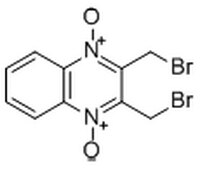530746 Sigma-AldrichPeroxiredoxin Inhibitor, Conoidin A - CAS 18080-67-6 - Calbiochem
A cell-permeable nematicidal compound that covalently binds to the peroxidatic cysteine of peroxiredoxin II in T. gondii and irreversibly blocks its hyperperoxidation activity (IC₅₀ = 23 µM).
More>> A cell-permeable nematicidal compound that covalently binds to the peroxidatic cysteine of peroxiredoxin II in T. gondii and irreversibly blocks its hyperperoxidation activity (IC₅₀ = 23 µM). Less<<Synonyms: 2,3-bis(Bromomethyl)quinoxaline-1,4-dioxide, Prx Inhibitor
Recommended Products
Overview
| Replacement Information |
|---|
Key Spec Table
| CAS # | Empirical Formula |
|---|---|
| 18080-67-6 | C₁₀H₈Br₂N₂O₂ |
Products
| Catalogue Number | Packaging | Qty/Pack | |
|---|---|---|---|
| 5.30746.0001 | Glass bottle | 25 mg |
| References | |
|---|---|
| References | Nguyen, J.B., et al. 2013. Chem. Biol. 20, 991. Haraldsen, J. D., et al. 2009. Org. Biomol. Chem. 7, 3040. Carey, K.L., et al. 2004. Proc. Natl. Acad. Sci. USA 101, 7433. |
| Product Information | |
|---|---|
| CAS number | 18080-67-6 |
| Form | Yelllowish brown solid |
| Hill Formula | C₁₀H₈Br₂N₂O₂ |
| Chemical formula | C₁₀H₈Br₂N₂O₂ |
| Reversible | N |
| Quality Level | MQ100 |
| Applications |
|---|
| Biological Information | |
|---|---|
| Primary Target | Peroxiredoxin |
| Primary Target IC<sub>50</sub> | 23 µM for blocking TgPrxII hyperperoxidation activity |
| Purity | ≥95% by NMR |
| Physicochemical Information | |
|---|---|
| Cell permeable | Y |
| Dimensions |
|---|
| Materials Information |
|---|
| Toxicological Information |
|---|
| Safety Information according to GHS |
|---|
| Safety Information |
|---|
| Product Usage Statements |
|---|
| Packaging Information | |
|---|---|
| Packaged under inert gas | Packaged under inert gas |
| Transport Information |
|---|
| Supplemental Information |
|---|
| Specifications |
|---|
| Global Trade Item Number | |
|---|---|
| Catalogue Number | GTIN |
| 5.30746.0001 | 04055977242942 |
Documentation
Peroxiredoxin Inhibitor, Conoidin A - CAS 18080-67-6 - Calbiochem SDS
| Title |
|---|
References
| Reference overview |
|---|
| Nguyen, J.B., et al. 2013. Chem. Biol. 20, 991. Haraldsen, J. D., et al. 2009. Org. Biomol. Chem. 7, 3040. Carey, K.L., et al. 2004. Proc. Natl. Acad. Sci. USA 101, 7433. |







